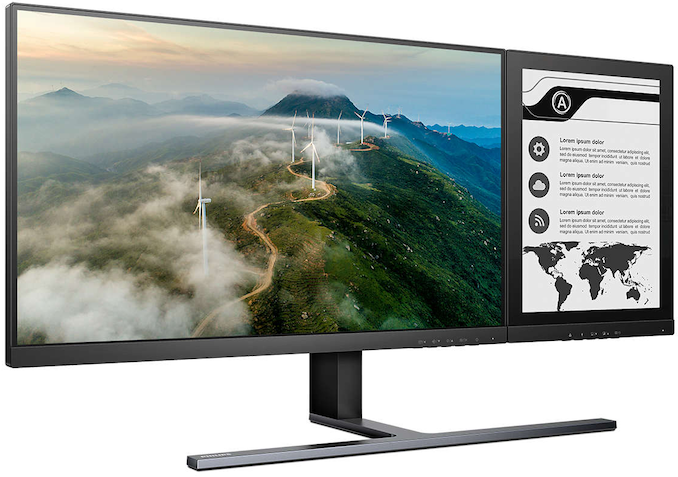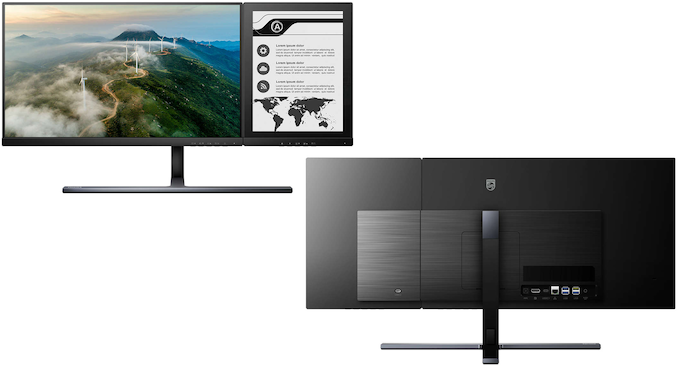Philips Reveals Dual Screen Display: a 24-Inch LCD with E Ink Secondary Screen
by Anton Shilov on May 11, 2023 2:00 PM EST
Although E Ink technology has remained a largely niche display tech over the past decade, it's none the less excelled in that role. The electrophoretic technology closely approximates paper, providing significant power advantages versus traditional emissive displays, not to mention making it significantly easier on readers' eyes in some cases. And while the limitations of the technology make it unsuitable for use as a primary desktop display, Phillips thinks there's still a market for it as a secondary display. To that end, Philips this week has introduced their novel, business-oriented Dual Screen Display, which combines both an LCD panel and and E Ink panel into a single display, with the aim of capturing the benefits of both technologies.
The Philips Dual Screen Display (24B1D5600/96) is a single display that integrates both a 23.8-inch 2560x1440 IPS panel as well as a 13.3-inch, greyscale 1200x1600 resolution E Ink display. With each display operating independently, the idea is similar to previous concepts of multi-panel monitors; however Phillips is taking things in a different direction by using an E Ink display as a second panel – combining two otherwise very different display technologies into a single product. By offering an E Ink panel in this product, Phillips is looking to court the market for users who would prefer the reduced eye strain of an E Ink display, but are working at a desktop computer, where an E Ink display would not be viable as a primary monitor.
As you might expect from the basic layout of the monitor, the primary panel is a rather typical office display that's designed for video and productivity applications – essentially anything where you need a modern, full color LCD. The secondary E Ink display, on the other hand, is a greyscale screen whose strength is the lack of flicker that comes from not being backlit by a PWM light. Both screens act independently, but since they are encased into the same chassis, they are meant to work together. For example, the secondary monitor can display supplementary information in text form, whereas the primary monitor can display photos.
Ultimately, Philips is pitching the display on the idea that the secondary screen can reduce the eye strain of the viewer while viewing documents. It's a simple enough concept, but one that requires buyers to overlook the trade-offs of E Ink, and the potential drawbacks of having two dissimilar displays directly next to each other.
Under the hood, the LCD panel on the Deal Screen Display is an unremarkable office-grade display. Phillips is using 23.8-inch anti-glare 6-bit + Hi FRC IPS panel with a 2560x1440 resolution, which can hit a maximum brightness of 250 nits while delivering 178-degree viewing angles. Meanwhile, the E Ink panel is a 13.3-inch 4-bit greyscale electrophoretic panel, with a resolution of 1200x1600. Notably here, there is no backlighting; the E Ink panel is meant to be environmentally lit (e.g. office lighting) to truly minimize eye strain.
When it comes to connectivity, the primary screen is equipped with a DisplayPort 1.2 and a USB Type-C input (with DP Alt mode and USB Power Delivery support), a USB hub, and a GbE adapter. Meanwhile, the secondary screen connects to host using a USB Type-C connector that also supports DP Alt Mode, and Power Delivery.
| Specifications of the Philips Dual Screen Display 24B1D5600/96 |
||
| Primary Screen | Secondary Screen | |
| Panel | 27" IPS 6-bit + Hi FRC | 13.3" E Ink 4-bit |
| Native Resolution | 2560 × 1440 | 1200 × 1600 |
| Maximum Refresh Rate | 75 Hz | ? |
| Response Time | 4ms | ? |
| Brightness | 250 cd/m² (typical) | ? |
| Contrast | 1000:1 | ? |
| Viewing Angles | 178°/178° horizontal/vertical | high |
| HDR | none | none |
| Dynamic Refresh Rate | none | none |
| Pixel Pitch | 0.2058 mm² | 0.2058 mm² |
| Pixel Density | 123 ppi | 150 ppi |
| Display Colors | 16.7 million | greyscale |
| Color Gamut Support | NTSC: 99% sRGB: 99% |
4-bit |
| Aspect Ratio | 16:9 | 3:4 |
| Stand | Height: +/-100 mm Tilt: -5°/23° Swivel: 45° |
|
| Inputs | 1 × DisplayPort (HDCP 1.4) 1 × USB-C (HDCP 1.2 + PD) |
1 × USB-C (HDCP 1.4 + PD) |
| Outputs | - | - |
| USB Hub | USB 3.0 hub | - |
| Launch Date | Q2 2023 | |
The Philips Dual Screen Display has a rather sleek stand which can adjust height, tilt, and swivel. It makes the whole unit look like one monitor rather than like two separate screens. Though to be sure, the E Ink portion of the display can be angled independently from the LCD panel, allowing the fairly wide monitor to contour to a user's field of view a bit better.
When it comes to pricing, Philips's Dual Screen Display is available in China for $850 (according to Liliputing), which looks quite expensive for a 24-inch IPS LCD and a 13.3-inch secondary screen. Though as this is a rather unique product, it is not surprising that it is sold at a premium.
Source: Phillips












15 Comments
View All Comments
stanleyipkiss - Thursday, May 11, 2023 - link
This is a great idea but poorly implemented... Why is the main screen 6bit? Why is there mismatching resolution between the two screens? Should've been at least 8 bit (preferrably 10 bit) main screen at 2560x1440 and a secondary E-ink screen at 1200x1440.Still ... a terrific idea.
meacupla - Thursday, May 11, 2023 - link
Those were my thoughts as well. 24" 6-bit 250nits 2560x1440 for $850 is a tough pill to swallow.I would prefer the main screen to have 1600 vertical, because 1200x1440 (5:6) is a poor fit for documents and book pages, which fit a 3:2 or 4:3 size better.
The downside with a 1600 vertical panel to match is that you would have to use some weird 22.2" screen size for a 16:10, or use a 28xx*1600 panel which won't quite be a perfect 16:9.
Another thing that seems to be missing is the ability to put the E-ink display on the left side.
back2future - Friday, May 12, 2023 - link
it's probably the 13.3" E Ink display, that's mostly >$400ballsystemlord - Thursday, May 11, 2023 - link
I concur.Samus - Sunday, May 14, 2023 - link
stanley couldn't have said it better. Unique, original concept here in a half-assed product. The IPS screen sucks (and frankly could even be PVA considering its target audience since VA panels offer deeper blacks and similar viewing angles) and the resolution of the e-ink screen is inherently incompatible with the primary screen resolutions, making dragging a windowed document to the e-ink screen clunky.meacupla - Thursday, May 11, 2023 - link
oh, and one other thing.You have got to be kidding me with those input options.
It has 2x USB-C for inputs, if you want to use the hub on the monitor.
Most run-of-the-mill "office" laptops only have 1x USB-C with DP+PD, and HDMI for video output.
To get 2x USB-C, you would have to use an expensive Envy or XPS.
I really don't see why the E-ink display couldn't have had an additional HDMI or DP port, unless the monitors are not even connected electronically, and the E-ink has to get its power over USB.
kepstin - Thursday, May 11, 2023 - link
This really should accept a single DisplayPort or USB-C input, and use MST to run both screens off one connection, yeah.StevoLincolnite - Thursday, May 11, 2023 - link
Good in theory, but poorly executed.6-bit@250nits is last decade.
Zoolook - Friday, May 12, 2023 - link
It was poor then as well, I have a display from 2006 still in daily use, 8-bit, there as never been an excuse for 6-bit display.Santoval - Tuesday, May 16, 2023 - link
Apart from cost...